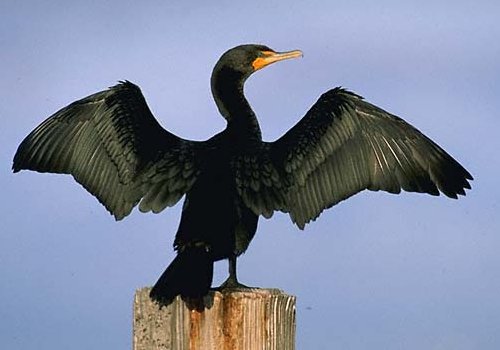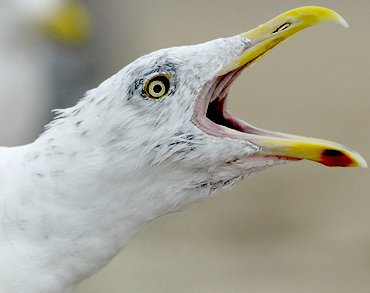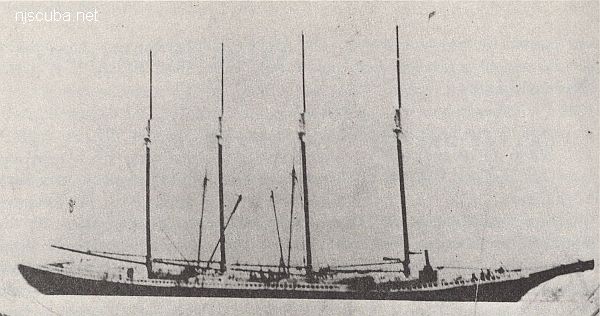Double-Crested Cormorant

What do you get when you cross a pigeon with a duck?
Phalacrocorax auritus
This large ( 27", wingspan 50" ) seabird is more likely to be seen around backwaters than in the open ocean. Cormorants seem rather poorly adapted to their lifestyle - they barely float, and their feathers are not waterproof like other waterfowl. As a result, they can often be seen standing on rocks and pilings or in trees in just this pose, sunning themselves to warm up and dry out after diving for fish. Despite this apparent disadvantage, they are quite successful and even manage to over-winter in the area. Cormorants are amazing swimmers and divers, able to catch fish underwater in their own environment.

The Double-Crested Cormorant
by Sue Canale
Double-crested cormorants ( Phalacrocorax auritus ) are a common sight in New Jersey, although many people may not be familiar with them. If you frequent any of the state's larger waterways, you've probably seen one. These large greenish-black waterbirds have orange facial skin, including an orange throat pouch, and webbed feet. They are often seen perched on pilings or towers with wings outstretched as if basking in the sun, which is exactly what they are doing. Immature birds are easily distinguished from their adult counterparts by the gray or tan plumage on the head and neck.

About 30 species of cormorants exist worldwide, with six occurring in North America. The double-crested cormorant is the most common and is the only one often observed inland. It is named for the two small tufts, or feather crests, that are briefly present on the heads of adults in breeding plumage.
The legs are located far back on the body, and when in the water, their bodies are totally submerged; only the head and neck are exposed, similar to the posture of loons. They can be differentiated from loons, however, by their slender hooked bill, which will be tilted slightly upward when swimming. Although both species dive for their dinner of fish, loons have thicker, longer bills that appear more pointed at the tip.
Double-crested cormorants have a breeding range that extends from southwestern Alaska to Mexico. They also nest on lakes from central Alberta to James Bay & Newfoundland, south along the coast to the Gulf of Mexico. The population we see here in New Jersey migrates south to spend its winters in the Gulf of Mexico, the Bahamas, and the Greater Antilles. Along the Pacific coast and in the southeastern US, populations are resident year-round.
In New Jersey, flocks flying in their typical sloppy or loose Vs are most frequently seen in the spring and summer. This trait, in combination with their dark coloring, probably led to the colloquial designation crow-ducks by early European settlers.
Double-crested cormorants nest in colonies in a variety of places, from rocky outcroppings, ledges, and sandy islets to trees near water and even power towers. New Jersey's five breeding colonies occur in four different physiographic regions, ranging from an inland site in Bergen County to a Delaware Bay site in Cumberland County. Their nests are generally constructed from loose twigs and wreck debris. They usually lay 3 to 4 light blue eggs that may have a white chalky covering. Incubation is shared by the adults and lasts from 25 to 28 days. Young cormorants fledge at about 10 weeks of age.
Double-crested cormorants were not recorded to breed in New Jersey until 1987 when colonies were discovered in lower Newark Bay. It may only be a matter of time, however, before we see increases in colonies and breeding populations. Large numbers of subadults and non-breeding birds can be seen loafing here during the breeding season, which lasts from mid-April to the end of August.
The diet of the double-crested cormorant consists of small shallow-water baitfish ( primarily alewife, rainbow smelt, and yellow perch ) and aquatic invertebrates, but will also take many game fish - a fact that has not gone unnoticed by sport anglers. Unfortunately, their diet has contributed to the major predicaments facing them: contamination and direct competition with human interests.
Aquaculturists and catfish farmers are often economically impacted by the appetite of these and other fish-eating birds. Like most avian species, cormorants are protected under the Migratory Bird Treaty Act, which includes provisions allowing individuals who experience economic losses to control the species. The Great Lakes population illustrates the need for sound biological assessment of local ecosystems and the need to balance the population with human economics. The cormorant colonies discovered there in the early 1920s grew so rapidly that anglers were calling for control measures by the 1940s. Early efforts concentrated on egg destruction, including spraying eggs with a formaldehyde and soap solution. By 1960, most sanctioned control had been suspended, but a more insidious control was taking hold.
Fish-eating bird populations were severely impacted by the effects of toxic chemical bioaccumulation, mainly DDE ( produced when an animal's body tries to rid itself of DDT ) and PCBs. DDE inhibits birds' ability to transfer calcium carbonate from their bones to the eggshell. Thinner eggshells cannot support the weight of an incubating bird. Because cormorants incubate their eggs by wrapping their webbed feet around them, essentially standing on them, they are particularly vulnerable to the effects of DDE.
By the early 1970s, toxic contamination had reduced the breeding population of Great Lakes double-crested cormorants by 86 percent. Legislative restrictions and voluntary reductions in the use of DDT and associated pesticides gradually enabled avian populations to rebound. By the late 1990s, the number of breeding pairs in the Great Lakes had increased to more than 8,000, but this resurgence precipitated a conflict involving the local sportfishing industry, which felt that the birds were devastating their livelihood. Nearly 900 cormorants were illegally shot and killed. While the individuals responsible were apprehended, this incident serves to remind us of the challenges inherent in balancing the implementation of sound wildlife management practices with human economics and the ecosystem dynamics of an area.
Sue Canale is a senior biologist with the Division of Fish and Wildlife's Office of Information and Education. Formerly on the staff of the division's Endangered and Non-game Species Program, she now focuses on marine education
This article first appeared in New Jersey Outdoors - Summer 2001


